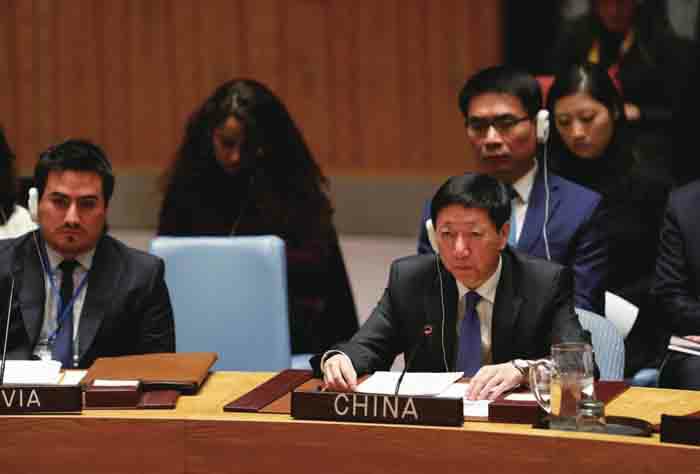A VICISSITUDINOUS ENVIRONMENT
2018-01-03ByQiHaixia
By+Qi+Haixia
The year 2017 is drawing to a close, with China having experienced a series of diplomatic frictions such as the Dong Lang Plateau standoff and the Terminal High Altitude Area Defense(THAAD) crisis. A review of the past 12 months h elps explain the dynamics of Chinas foreign relations and its future trend.
Potential chain reaction
Sino-U.S. relations have always been the focal point of Chinas foreign affairs, yet ever since the U.S. pivot to the Asia-Pacific re-gion, the development of Sino-U.S. relations has started to meet increasing resistance. This year, before the mutual visits between China and the U.S. by their national leaders, bilateral relations have been affected by the THAAD crisis, the South China Sea dispute, the Taiwan question, trade frictions and so on. On the Taiwan question, the U.S. authorized a $1.4-billion arms sale to the Chinese island in June. In July, the U.S. Congress deliberated and approved the bill named Defense Authorization for Fiscal Year 2018, which demands the defense secretary assess the possibility of U.S. warships visiting Taiwan. In October, the Foreign Affairs Committee of the U.S. House of Representatives deliberated and approved the “Communication With Taiwan” bill. On the THAAD crisis, initiated by the U.S. and South Korea, the latter arranged“temporary” deployment of the THAAD antimissile system in September. Regarding trade frictions, U.S. trade representative Robert Lighthizer claimed in September that China and its industrial policy have brought“unprecedented threats” to the world trade system. Clearly, Sino-U.S. diplomatic relations witnessed frictions in multiple ways.
In addition to the above events, the fact that the U.S. constantly displays a military presence in the South China Sea is most striking. In May 2017, the USS Lawrence destroyer sailed within 12 miles of Chinas Meiji Reef under the pretext of “freedom of navigation.” In July, the USS Stethem missile destroyer made an unauthorized entry into the territorial waters of Chinas Xisha Islands. In August, the USS John S. McCain missile destroyer made an unauthorized entry into waters around Chinas Nansha Islands, and in October, the USS Chaffee destroyer entered the territorial waters of Chinas Xisha Islands.
There are two motives for the frequent appearance of the U.S. Navy around the borders of China. First, the U.S. is testing Chinas red line in relation to its core interests. Second, the U.S. takes advantage of the situation to exhibit its determination to maintain its global hegemony. Since the U.S. is a maritime power, its multiple intrusions into Chinas territorial waters in the guise of“freedom of navigation” show its far-fetched concern about the South China Sea dispute and its support for its Asia-Pacific allies. The strong action by the U.S. has nonetheless narrowed the leeway for China in the dispute.endprint
There is still much room for bilateral cooperation to improve, in that the U.S. needs Chinas assistance on the issue of North Korea. Nevertheless, in general, conflicts between China and the U.S. have become central to the many problems of Chinas diplomacy. Inevitably, Sino-U.S. relations have implications for other diplomatic relations of China, so any conflict in them can potentially set off a chain reaction in Chinas diplomatic efforts.
Diplomatic ties
Upon initial announcement of the pivot to Asia strategy by the U.S., a number of AsiaPacific countries took advantage of the situation by waiting for the best “bidding price” either from the U.S. or from China. For example, India in effect changed its selfproclaimed “non-alignment policy” and sided with the U.S. after it instigated the Dong Lang Plateau confrontation with China from June to August this year. To illustrate, India signed a civil nuclear agreement with the U.S. in 2008. In 2010, the U.S. supported Indias attempt to become a permanent member of an enlarged UN Security Council. In January 2015, India and the U.S. signed their Joint Strategic Vision of the Asia-Pacific and Indian Ocean Regions. It is thus evident that the deepening military cooperation between the U.S. and India is one of the reasons why India chose a hardline stance in the Doklam Plateau confrontation.
Meanwhile, the stances of traditional U.S. allies Japan and South Korea became more explicit as well. From 2009 to 2015, even though the U.S. announced its return to the Asia-Pacific, the China policy of Japan and that of South Korea obviously diverged. While Japan has continuously battled with China on the Diaoyu Island issue, South Korea remained relatively neu- tral. However, as the U.S. strengthens its efforts to contain the rise of China, South Korea, as a U.S. ally, finds it hard to remain inactive. Since 2016, the THAAD crisis has led to hostility between China and South Korea, with the latter deploying the THAAD antimissile system regardless of repeated protests from China.
Sino-Japanese relations have not made substantial progress this year. Japans tough position on China may be related to its domestic political climate. Since the economic crisis in the 1990s, the Japanese economy has been suffering from a long-term recession, and society has been fraught with rising public dissatisfaction with the government. Consequently, the Shinzo Abe administration has relied on hawkish foreign policies in order to garner domestic support and ardently sought U.S. backing. When then President Barack Obama visited Japan in 2014, the two allies made a joint statement that the U.S.-Japan Security Treaty applies to the Diaoyu Islands. In August 2017, the 2+2 talks held by the foreign affairs and defense ministers of the U.S. and Japan issued a joint statement which also claimed that Article Five of the U.S.-Japan Security Treaty applies to the Diaoyu Islands and expressed “serious concern” about the situation in the South China Sea. Such claims increase the risk of the U.S. being dragged into a potential China-Japan conflict.endprint

Concerned with Trumps “America First” policy, European countries have started to show disaccord in their foreign policy approaches with the U.S. France and Germany have both voiced discontent over the U.S. withdrawal from the Trans-Pacific Partnership Agreement and the Paris climate accord. The divergent trend between the U.S. and its European allies is expected to continue in the near future. The Trump administration will prioritize U.S. interests in deciding the extent to which the nation should shoulder international responsi-bilities and provide global public goods, which will inadvertently hurt the interest of traditional European powers. Under such circumstances, the China policy of France and Germany has remained relatively stable at a time when both nations are seeking other reliable partners around the globe.
Sino-Russian relations continue to improve, with frequent interactions between the leaders of the two sides. In May, Russian President Vladimir Putin visited China to attend the Belt and Road International Cooperation Forum. In July, Chinese President Xi Jinping paid a state visit to Russia. In September, Putin attended the ninth summit meeting of the BRICS leaders and participated in the Emerging Markets and Developing Countries Dialogue in Xiamen, China. In addition, military exchanges between the two nations have been deepened further. The second stage of the Sino-Russian Marine Cooperation 2017 military drill was held in waters between the Peter the Great Gulf in the Sea of Japan and the southern area of the Sea of Okhotsk. Among major nations, Russia, which has a comprehensive strategic partnership with China, has had the closest relations with China. The improved Sino-Russian relations are due partly to containment by the U.S. Since 2007, China and Russia vetoed eight times against the proposals raised in the UN. The latest such joint veto occurred in February this year against a bill to impose sanctions on Syria for the alleged use of chemical weapons. Predictably, China and Russia will strengthen their cooperation in the future to balance U.S. clout.
Diplomacy ahead
Most recently, there have been significant changes in Chinas diplomatic relations stemming from changes in the United States China policy. As containment by the U.S. will last for quite some time, the following judgments can be made for the coming year.
First, in aspects such as the Taiwan question, the South China Sea dispute and the North Korean nuclear issue, it is still difficult for the differences between China and the U.S. to be bridged promptly. However, the rationale behind the U.S. containment of China is to slow down the speed of Chinas rise, rather than to become involved in regional conflicts. It can be expected that the two nations will effectively control crisis and avoid security dilemmas. Since the U.S. is unlikely to budge on its maritime power, it will normalize its “free navigation” in the waters in the South China Sea.endprint

Second, the security risk in the AsiaPacific area will move from the South China Sea to Northeast Asia. The focus of the South China Sea dispute is the sovereignty of the islands and reefs. With the change of policy position of the Philippines, the risk of escalation in the area has been subdued. However, Northeast Asia faces rising risks largely due to the North Korean nuclear program. North Korea seeks to increase its bargaining power by developing nuclear weapons in an attempt to force the U.S. to recognize it as a nuclear weapons state and maintain its national security. Nevertheless, its test firings of missiles have disrupted the international nuclear order and exacerbated the regional security situation. The joint defense drill between South Korea and the U.S. conducted this August and the joint naval drill between the two countries conducted in October in the seas around the Korean Peninsula showed some of the consequences of the test firings. Nonetheless, North Korea is as unlikely to stop its quest for nuclear weapons as are the U.S. and South Korea to cease responding accordingly, hence a security dilemma is forming in Northeast Asia.
Last but not least, the United Statescontainment of China is a result of the“America first” policy approach. For instance, in the field of economy and trade, Sino-U.S. friction may intensify because the U.S. aims to increase its domestic employment rate. Also because of “America first,” European allies of the U.S. may remain relatively friendly toward China in diplomatic matters.endprint
